1.6 Conservation of Energy in Fluid Flow
3 min read•november 21, 2020
K
Krish Gupta
AP Physics 2 🧲
61 resourcesSee Units
Conservation of Energy in Fluid Flow
You have most likely already learned about conservation of energy in a previous course or worked with the ideas of kinetic energy and potential energy 🎢. The same principles apply to fluids, with a few small differences. The main difference is that the fluids we work with have densities and volumes, while with solids you mostly deal with masses.
Using the conservation of energy principle and making substitutions using the fact that density = mass/volume we arrive at a formula called the Bernoulli’s equation.


Bernoulli’s equation makes some basic assumptions. If the fluid is incompressible, has streamline (smooth) flow or negligent turbulent (rough) flow, and has negligible viscosity (internal friction), we can use this equation. The test will most likely not give you a situation where you have to deal with these exceptions. Treat this just as you treated air resistance or edge effects in Physics 1. Even though these topics are not usually tested on the exam, it is beneficial to know that they can have some effect on our results.
Water is flowing at a rate of 2m^3/s through a tube with a diameter of 1m. If the pressure at this point is 80kPa, what is the pressure of the water after the tube narrows to a diameter of 0.5m?
We need Bernoulli's equation to solve this problem:
P1 + 12ρv1 + ρgh1 = P2 + 12ρv2 + ρgh2
The problem statement doesn't tell us that the height changes, so we can remove the last term on each side of the expression, then arrange to solve for the final pressure:
P2 = P1 + 12ρ(v1−v2)
We know the initial pressure, so we still need to calculate the initial and final velocities. We'll use the continuity equation:
V=vA
Rearrange for velocity:
v=V/A
Where A is the cross-sectional area. We can calculate this for each diameter of the tube:
A1 = πd24 = π (1m) 24 = π4m
A2 = πd24 = π (0.5m) 24 = π16m
Now we can calculate the velocity for each diameter:
v1 = 2m3sπ4m = 8πms
v2 = 2m3sπ16m = 32πms
Now we have all of the values needed for Bernoulli's equation, allowing us to solve:
P2 = (80,000Pa) + 12(1000kgm3) (8π−32π)
P2 = (80,000Pa) + (500)(−24π) = 76.2kPa
A special case of this is a leaking tank.

The water at the top of the container has potential and kinetic energy, but so does the water leaking from the side. Since the same amount of water is leaking from the side as is decreasing from the top, their flow rates are equal.
The flow rate is defined as the area multiplied by velocity of the liquid. More to come on this in the final section.
Since the top has a much bigger area, it’s velocity is almost negligent and hence we ignore the kinetic energy at the top. Also, since both the top and the leak are exposed to the atmosphere we ignore the initial pressures.

You can see how this equation reminds us of an object in free fall from the kinematics unit from Physics 1. PHYSICS CONNECTS TOGETHER. 😎🤯😎
Browse Study Guides By Unit
💧Unit 1 – Fluids
🔥Unit 2 – Thermodynamics
⚡️Unit 3 – Electric Force, Field, & Potential
💡Unit 4 – Electric Circuits
🧲Unit 5 – Magnetism & Electromagnetic Induction
🔍Unit 6 – Geometric & Physical Optics
⚛️Unit 7 – Quantum, Atomic, & Nuclear Physics
✏️Frequently Asked Questions
📆Big Reviews: Finals & Exam Prep

Fiveable
Resources
© 2023 Fiveable Inc. All rights reserved.